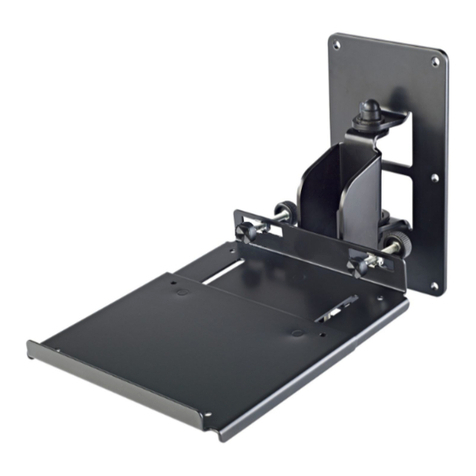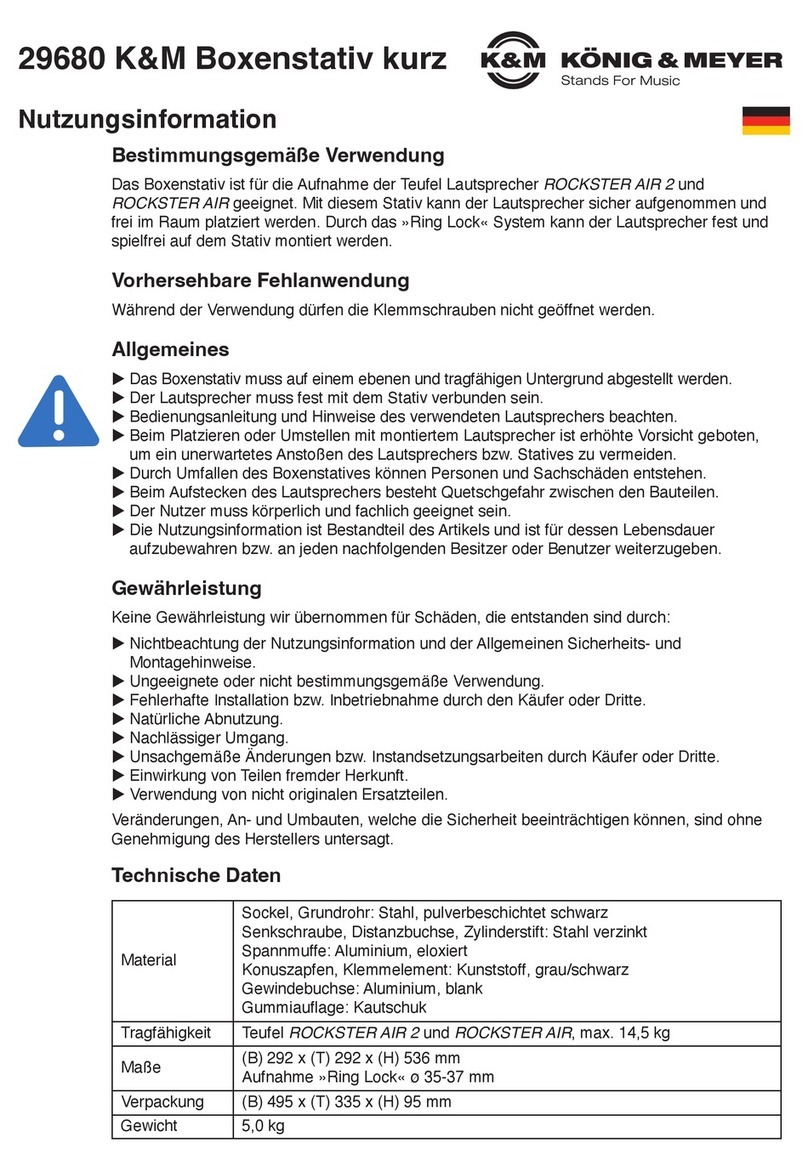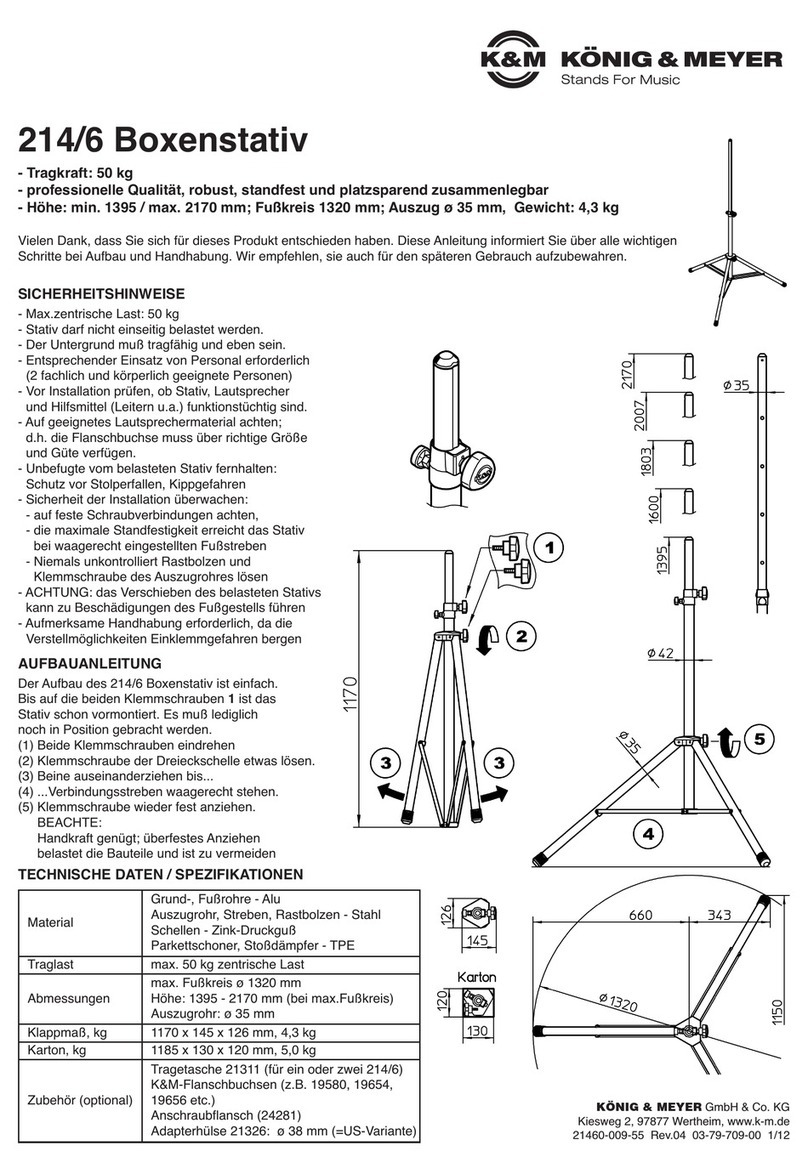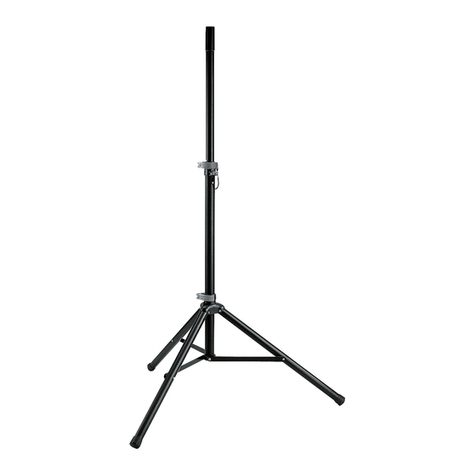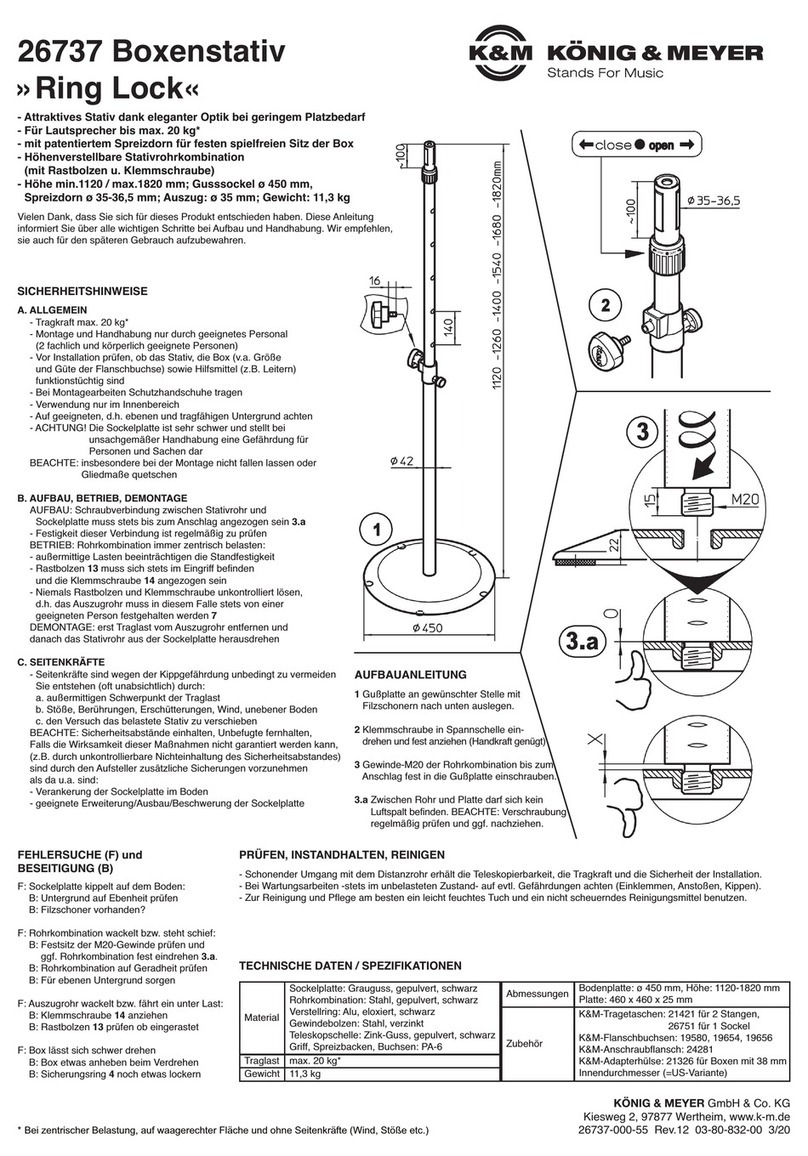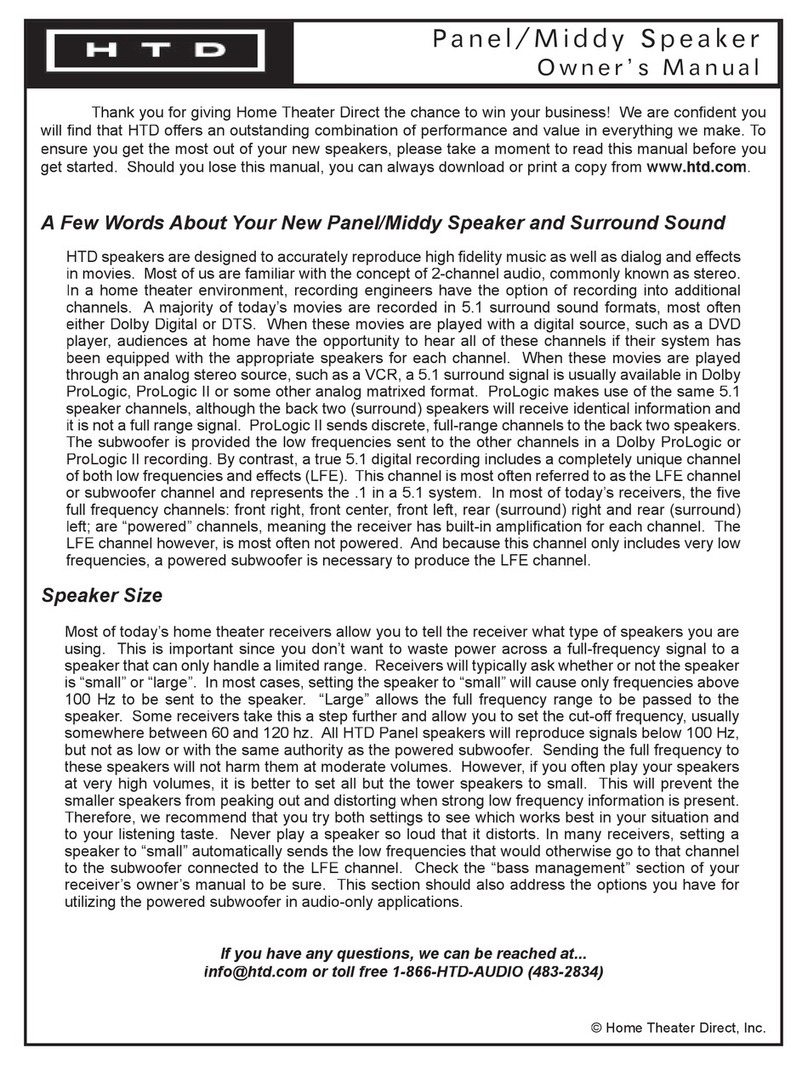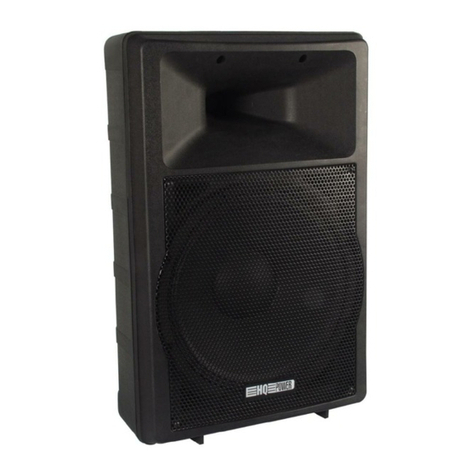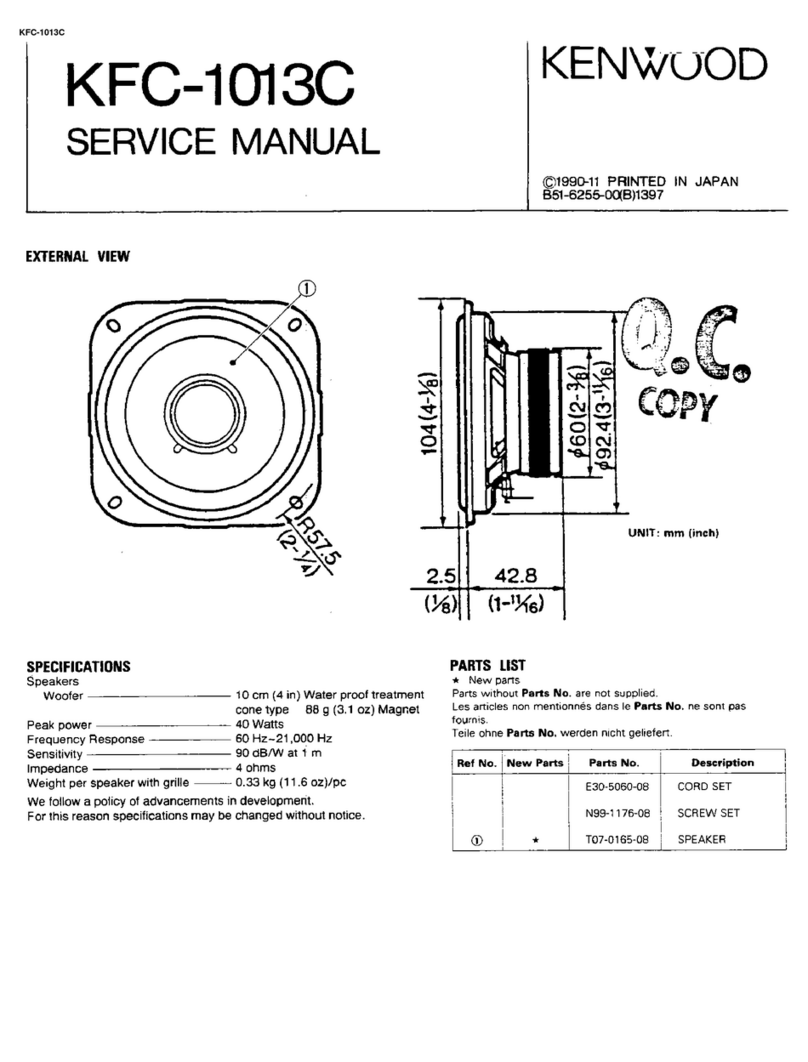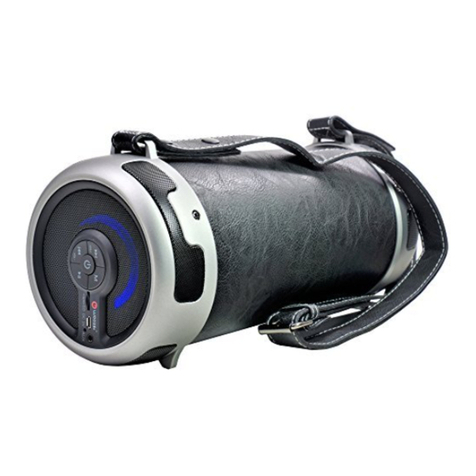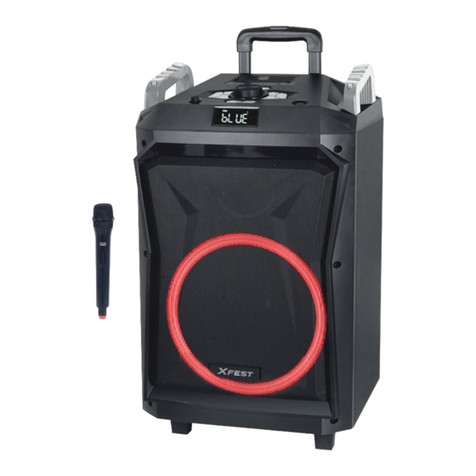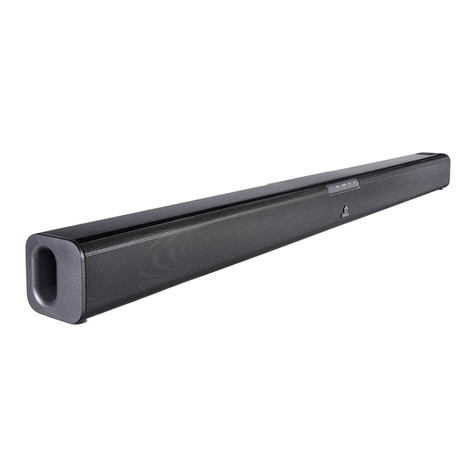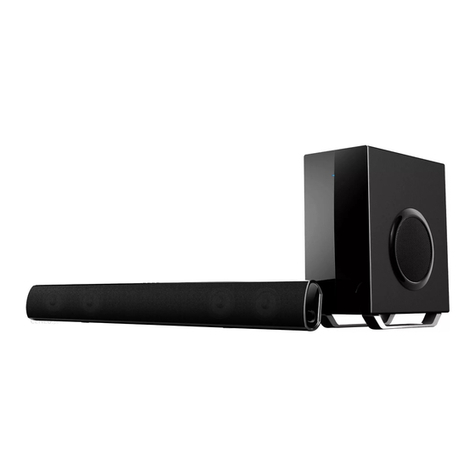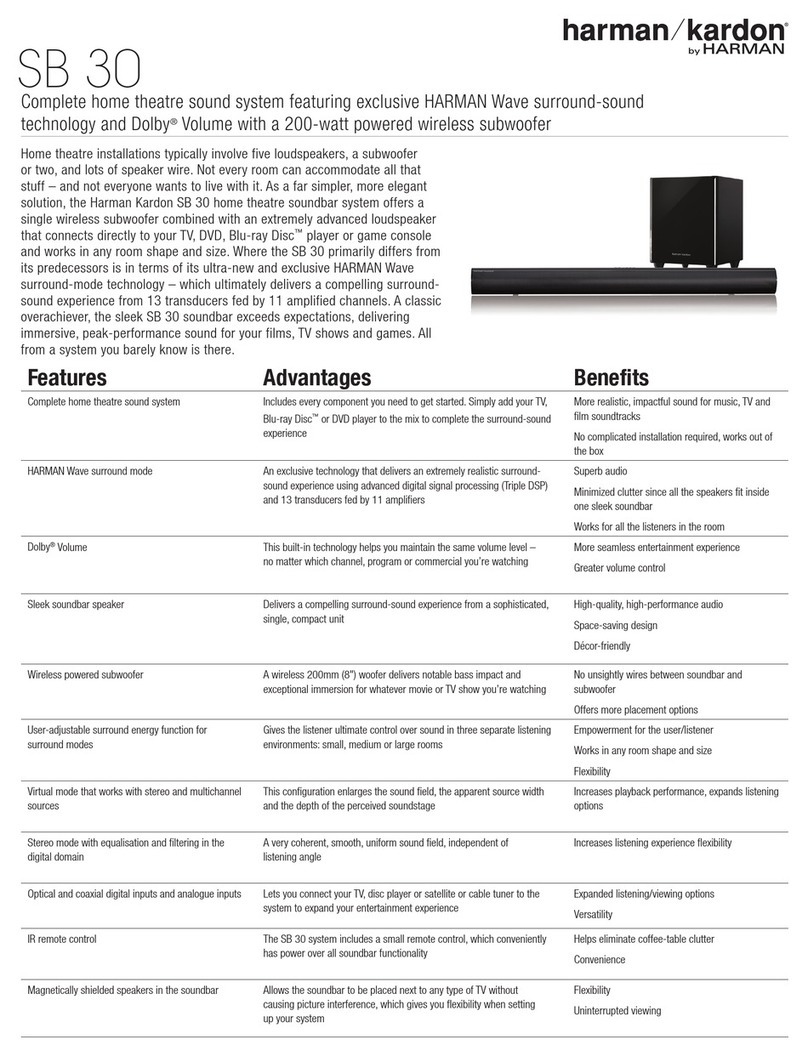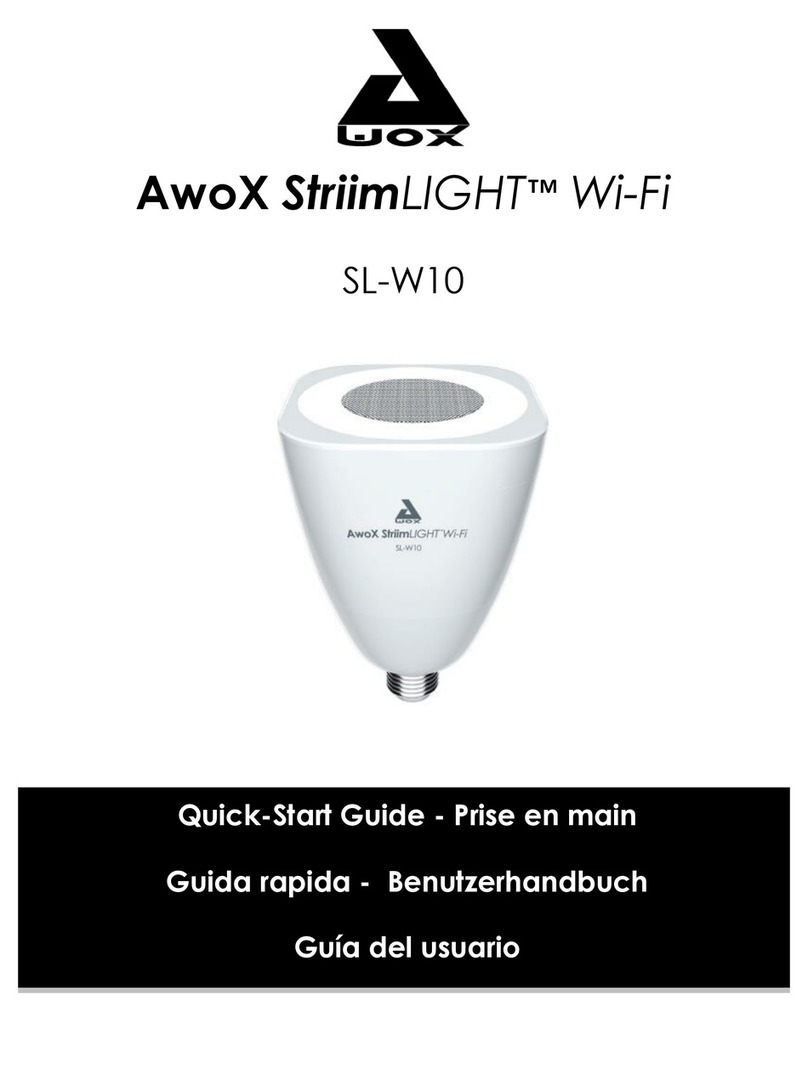Konig & Meyer 26734 User manual

KÖNIG & MEYER GmbH & Co. KG
Kiesweg 2, 97877 Wertheim, www.k-m.de
26734-000-55 Rev.07 03-80-399-00 3/20
26734 Boxenstativ
- Attraktives Stativ dank eleganter Optik bei geringem Platzbedarf
- Tragkraft max. 20 kg*
- Höhenverstellbare Stativrohrkombination (mit Rastbolzen und Klemmschraube)
- Schwere Sockelplatte aus Stahl, mit Tragegriff, Steckeröffnung und 4 Füßen mit
-Filzauflage
- Höhe 1100-1810 mm; Auszug: ø 35 mm, mit Aufsteckhilfe; Sockel 480 x 480 mm;
-Gewicht: 12,85 kg
SICHERHEITSHINWEISE
Vielen Dank, dass Sie sich für dieses Produkt entschieden haben. Diese Anleitung informiert Sie über alle wich-
tigen Schritte bei Aufbau und Handhabung. Wir empfehlen, sie auch für den späteren Gebrauch aufzubewahren.
A. ALLGEMEIN
A. - Tragkraft max. 20 kg*
A. - Entsprechender Einsatz von Personal erforderlich (ggf. 2 fachlich u. körperlich
A. -geeignete Personen)
A. - ACHTUNG! Die Sockelplatte ist sehr schwer und stellt bei unsachgemäßer Hand-
A. -habung eine Gefährdung für Personen und Sachen dar
A. - Bei Montagearbeiten Schutzhandschuhe tragen
A. - Insbesondere bei der Montage nicht fallen lassen oder Gliedmaße quetschen
A. - Sockelplatte und Rohrkombination müssen bis zum Anschlag fest verschraubt sein
A. - Aufmerksame Handhabung erforderlich, da die Verstellmöglichkeiten Einklemm-
A. -gefahren bergen
A. - Das Verschieben des Stativs, v.a. unter Belastung, ist nicht erlaubt (Kippgefahr,
A. -Bauteilbelastung)
A. - Unbefugte Personen vom belasteten Stativ fernhalten
A. - Verwendung nur im Innenbereich
B. VOR DEM BETRIEB
B. - Vor und nach Benutzung ist am Stativ eine Sichtprüfung vorzunehmen, ob alle
B. -Bestandteile vorhanden und soweit erkennbar in Ordnung sind.
B. - Beschädigte Stative dürfen entweder nicht weiter eingesetzt bzw. sie müssen
B. -zuvor einer qualifizierten Reparatur unterzogen werden.
B. - Traglasten und Hilfsmittel (z.B. Leitern) sind ebenfalls auf Tauglichkeit zu prüfen.
B. - Auf geeigneten, d.h. ebenen und tragfähigen Untergrund achten.
C. AUFSTELLUNG DES STATIVS
C. - Beachten Sie die Angaben im Kapitel AUFSTELLANLEITUNG
C. - Schraubverbindung zwischen Stativrohr und Sockelplatte muss stets bis zum
C. -Anschlag angezogen sein 3.a
C. - Rohrkombination zentrisch belasten, da außermittige Belastung die Standfestigkeit
C. -der Installation beeinträchtigt
C. - Rastbolzen 16 muss sich stets im Eingriff befinden
C. - Klemmschrauben fest anziehen - jedoch ohne Einsatz von Werkzeugen.
C. -Handkraft genügt völlig, zumal überfestes Anziehen die Bauteile belastet
C. - Niemals Rastbolzen 16 und Klemmschraube 18 unkontrolliert lösen
D. WÄHREND DES BETRIEBES
D. Die Sicherheit während des Betriebes beruht auf:
D. 1. ...BEACHTUNG der hier unter A - E. genannten Punkte.
D. 2. ...BEHERRSCHUNG von SEITENKRÄFTEN (>KIPPGEFÄHRDUNG).
D. 2. Seitenkräfte sind unbedingt zu vermeiden. Sie treten auf bei:
D. 2. a. schräg stehendem Stativ (unebener Boden)
D. 2. b. außermittigem Schwerpunkt der Traglast
D. 2. c. externen Schocks wie Stößen, Zerren am Stativ, Erschütterungen, Wind etc.
D. 2. BEACHTE: Sicherheitsabstände einhalten, Unbefugte fernhalten;
D. 2. Falls die Wirksamkeit dieser Maßnahmen nicht garantiert werden kann,
D. 2. (z.B. durch unkontrollierbare Nichteinhaltung des Sicherheitsabstandes) sind durch den
D. 2. Aufsteller zusätzliche Sicherungen vorzunehmen, z.B. das Abspannen mit Seilen,
D. 2. Verankerung der Sockelplatte im Boden- geeignete Erweiterung/Ausbau/Beschwerung
D. 2. der Sockelplatte
E. DEMONTAGE
E. - Traglast stets langsam und kontrolliert einfahren lassen.
E. - Erst die Traglast entfernen - dann das Stativrohr aus der Sockelplatte herausdrehen
AUFSTELLANLEITUNG
1Sockelplatte an gewünschter Stelle mit Standfüßen nach unten auslegen.
2Klemmschraube in Spannschelle eindrehen
3Gewinde-M20 der Rohrkombination bis zum Anschlag fest in die Sockelplatte einschrauben.
3.a Zwischen Rohr und Platte darf sich kein Luftspalt befinden
3.a BEACHTE: Verschraubung regelmäßig prüfen und ggf. nachziehen.
BENUTZERHINWEISE / FUNKTIONEN
AUSRICHTUNG der ROHRKOMBINATION
- Nachdem die Rohrkombination wie gefordert bis zum Anschlag eingedreht wurde,
-weisen deren Bedienelemente möglicherweise in eine unerwünschte Richtung. Dies
-kann korrigiert werden.
- Wir empfehlen dabei mit 2 Personen zu arbeiten: eine hält die Platte, die andere das Rohr
4Kontermutter auf der Unterseite der Platte mit dem Schlüssel losschrauben
5Das Rohr etwas hin- und her bewegen, damit sich die Gewindebuchse aus der Platte löst
6Rohr nun in gewünschte Richtung drehen und Gewindebuchse wieder in die Platte führen
7Kontermutter ansetzen und mit dem Schlüssel wieder fest anziehen
TRAGEGRIFF
8Der komfortabel gestaltete Tragegriff schützt ihre Hände und macht Transport und
8Installierung der Sockelplatte angenehmer und damit auch wesentlich sicherer.
STANDFÜSSE
Zum Schutz des Bodens ruht die Sockelplatte auf vier verschraubten Standfüßen mit
Filzauflage.
9Gelockerte Standfüße mit einem Steckschlüssel (SW8 = M5) wieder festschrauben.
KABEL-/STECKERÖFFNUNG
10 Optisch ansprechend: Kabel werden unter der Sockelplatte verlegt.
11 Technisch auf der sicheren Seite: die Öffnung bietet Platz für alle gängigen
11 Steckertypen und der Kunststoffring schützt das Kabel vor scharfen Kanten.
BESTANDTEILE
AUFBAU-
ANLEITUNG
AUSRICHTUNG der ROHRKOMBINATION
TRAGEGRIFF
KABEL-/STECKERÖFFNUNG
STANDFÜSSE

BENUTZERHINWEISE / FUNKTIONEN
TRAGLAST AUFBRINGEN und AUSFAHREN
ACHTUNG!
Unterschätzen Sie nicht das Gewicht des Lautsprechers
- Das Aufsetzen und Aus- bzw. Einfahren des Lautsprechers muss durch
-fachlich und körperlich geeignetes Personal erfolgen.
- Auszugrohr während der Höhenverstellung mit festem Griff halten 12 und
-die gewünschte Endstellung stets mit dem Rastbolzen 16 sichern.
- Das Auszugrohr endet in einem kegeligen Zapfen, der sogenannten
-Aufsteckhilfe, die das Aufsetzen des Lautsprechers wesentlich erleichtert
PRÜFEN, INSTANDHALTEN, REINIGEN
DAS BEWEGEN DER TRAGLAST
Beteiligte:
ERSTE PERSON: bedient das Auszugrohr mit der Traglast 12, 17
ZWEITE PERSON: bedient an der Spannschelle
ZWEITE PERSON: a. die Klemmschraube 13, 18 und
ZWEITE PERSON: b. den Rastbolzen 14, 16
WICHTIG!
Sollte das belastete Auszugrohr von der ERSTEN PERSON nicht mehr
sicher gehalten werden können, so muss die ZWEITE PERSON:
a. sofort die Klemmschraube 18 anziehen,
b. ebenfalls sofort den Rastbolzen 16 loslassen, damit dieser
b. selbständig in die nächstliegende Bohrung einrasten kann.
AUSFAHREN DER TRAGLAST
- Schonender Umgang mit dem Distanzrohr erhält die Teleskopierbarkeit, die Tragkraft
-und die Sicherheit der Installation
- Bei Wartungsarbeiten -stets im unbelasteten Zustand- auf evtl. Gefährdungen achten
-(Einklemmen, Anstoßen, Kippen)
- Zur Reinigung und Pflege am besten ein leicht feuchtes Tuch und ein nicht scheuerndes
-Reinigungsmittel benutzen
Anwendungs-beispiele (nicht im Liefer-umfang enthalten) Innen-ø 35,5 mm
ERSTE PERSON: ZWEITE PERSON:
12 hält das belastete Auszugrohr
12 mit beiden Händen gut fest
15 stemmt das Auszugrohr
15 mitsamt der Traglast in die
15 ungefähr gewünschte Höhe;
15 BEACHTE:
15 zum einfachen Auffinden der
15 entsprechenden Rastbohrung
15 sollte sich diese in jenem
15 Moment kurz über der
15 Spannschelle befinden
17 lässt das Auszugrohr lang-
17 sam ab bis der Rastbolzen
17 nun ins entsprechende
17 Loch einrastet
13 lockert die Klemmschraube
13 und hält diese fest
14 zieht am Griff des Rastbolzens
14 bis der Rastbolzen nicht mehr
14 in das Auszugrohr eingreift
16 lässt den Griff des Rastbolzens
16 los damit dieser selbständig ins
16 Auszugrohr einrasten kann
18 dreht die Klemmschraube fest
18 (Handkraft genügt)
EINFAHREN DER TRAGLAST
ERSTE PERSON: ZWEITE PERSON:
12 hält das belastete Auszugrohr
12 mit beiden Händen gut fest
17 lässt das Auszugrohr langsam
17 und kontrolliert ab
17 hält nach wie vor das Auszug-
17 rohr fest und sichert so das
17 nun ins entsprechende
17 kontrollierte Einfahren ab.
13 lockert die Klemmschraube
13 nur ganz wenig und...
14 ...entriegelt den Rastbolzen
18 dosiert die Klemmkraft der
18 Schraube so, dass das
18 Auszugrohr aufgrund der
18 Reibung in der Spannschelle
18 nicht plötzlich und ungebremst,
18 sondern langsam einfährt.
TECHNISCHE DATEN / SPEZIFIKATIONEN
FEHLERSUCHE (F) und BESEITIGUNG (B)
Material
Sockelplatte, Füße, Rohre: Stahl, schwarz gepulvert
Gewinde: Stahl verzinkt
Schelle: Zink-Druckguss, schwarz
Kabelschutz: PA-6, schwarz
Tragegriff: TPE, schwarz
Traglast max. 20 kg*
Abmessungen
Sockelplatte : 480 x 480 x 20 mm
Rohrkombination: ø 42 / ø 35 mm; mit Aufsteckhilfe
Höhe: min. 1112 - max. 1812 mm
Gewicht netto: 12,85 kg, brutto: 15 kg
Zubehör
(optional)
K&M-Flanschbuchsen (z.B. 19580, 19654, 19656)
Anschraubflansch (24281)
Adapterhülse 21326: ø 38 mm (=US-Variante)
Tragetasche 24628 für Bodenplatte
Tragetasche 21422 für Rohrkombination
F: Sockelplatte 1kippelt auf dem Boden:
F: B: Untergrund auf Ebenheit prüfen
F: B: Sockelplatte auf Ebenheit prüfen
F: B: Standfüsse 9locker?, nachziehen mit Steckschlüssel (SW8 = M5)
F: Rohrkombination wackelt bzw. steht schief:
F: B: Festsitz der M20-Gewinde prüfen, Grundrohr fest eindrehen 3
F: B: Kontermutter 4locker?, nachziehen mit Schlüssel -SW40- 7
F: B: Rohrkombination auf Geradheit prüfen
F: B: Für ebenen Untergrund sorgen
F: Rohrkombination falsch ausgerichtet
F: B: Kontermutter 4lockern, Rohrkombination in gewünschte Richtung
F: B: drehen 6und Position durch Anziehen der Kontermutter 7sichern
*Bei zentrischer Belastung, auf waagerechter Fläche und ohne Seitenkräfte (Wind, Stöße etc.)

KÖNIG & MEYER GmbH & Co. KG
Kiesweg 2, 97877 Wertheim, www.k-m.de
26734-000-55 Rev.07 03-80-399-00 3/20
26734 Speaker stand
- Attractive stand thanks to its elegant design for tight spaces
- Load bearing weight max. 20 kg*
- Height adjustable stand tube combination (with locking pin and clamp screw)
- Heavy base plate made of steel, comfortable handle, plug opening and
-4 felt covered feet
- Height 1100-1810 mm; Distance Rod: ø 35 mm, Placement Guide;
-Base 480 x 480 mm; Weight: 12,85 kg
SAFETY NOTES
Thank you for choosing this product. The instructions provide directions to all of the important setup and
handling steps. We recommend you keep these instructions for future reference.
A. GENERAL
A. - Load bearing weight: max 20 kg*
A. - Proper assignment of setup crew (if needed we recommend 2 physically fit technicians)
A. - IMPORTANT! The base plate is very heavy and improper use can result in risk to
A. -individuals and objects
A. - Wear protective gloves during assembly
A. - In particular, during assembly do not drop the load - or crush limbs
A. - Base plate and tube combination must be screwed in as far as it goes
A. - Careful and attentive handling is required when adjusting the stand - due to the possibility
A. -of pinching or wedging your hand
A. - Moving of the stand, particularly if the speakers are attached, is not permitted (Could fall
A. -over, component stress)
A. - Keep unauthorized personnel away from the stand with speaker
A. - Only to be used indoors
B. PRIOR TO USE
B. - The stand should undergo visual inspection prior to and after use, to ensure that
B. -all components are there and to the extent visible in working order.
B. - Damaged stands may either not be used unless they undergo repair
B. -by a qualified technician.
B. - Equipment and aids (e.g. Ladders) are to be inspected to ensure that they
B. -are in working order.
B. - Be sure that the surface will bear the load and is suitable and level.
C. STAND SETUP
C. - Please consider the information provided in the SETUP INSTRUCTIONS
C. - The screw connection between the stand tube and base plate must be screwed in as far
C. -as it will go 3.a
C. - The weight tube combination must be centered, un-centered loads can
C. -negatively affect the stability of the stand
C. - Locking pin 16 must be locked into place
C. - Tighten the clamp screws - without the use of screws.
C. -Manual strength is enough, over-tightening can negatively affect the components.
C. - Never loosen the locking pin 16 and the clamp screw 18 without having someone
C. -hold the speakers on the stand
D. DURING OPERATION
D. Safety during operation is based on:
D. 1. ...FOLLOWING the points listed here under A - E.
D. 2. ...MASTERING the LATERAL FORCES (DANGER OF THE STAND FALLING OVER).
D. 2. Lateral forces should be avoided at all costs. They occur in the case:
D. 2. a. the stand is tilted (uneven surface)
D. 2. b. the load bearing weight is not centered
D. 2. c. external shocks such as bumping into the stand, brushing into the stand, wind etc.
D. 2. NOTE: Maintain safety distance, keep unauthorized persons away;
D. 2. Should the effectiveness of the measures not be guaranteed,(e.g. through the safety
D. 2. distance not being kept and not being checked) the installer should implement the
D. 2. following additional steps, e.g. rigging, anchoring of the base plate to the floor - suitable
D. 2. extension/expansion/weighting down of the base plate
E. DISASSEMBLY
E. - Let the speaker retract slowly and in a controlled fashion.
E. - First remove the speaker - then unscrew the stand tube from the base
SETUP INSTRUCTIONS
1Base plate with feet are to be placed feet down in the desired position.
2Screw the clamp screw into clamping bracket
3Threaded connector -M20 of the tube combination is to be screwed into the base plate
3as far as it will go.
3.a Ensure that a space is not left between the tube and the plate
3.a NOTE: Regularly check and tighten the screws, if needed.
USAGE NOTES / FUNCTION
DIRECTION of the TUBE COMBINATION
- After the tube combination has been screwed in as far as it will go, the operation
-elements could point in an undesired direction. This can be corrected.
- We recommend that two people are used for this: one person holds the plate and the
-other person holds the tube
4The counter nut on the underside of the plate are loosened with an allen wrench
5The tube is moved back and forth a bit, so that the female threaded bolt can be
5removed from the plate
6Now turn the tube in the desired direction and feed the female threaded bolt into the plate
7Place the counter nut in the proper position and tighten them with the allen wrench
HANDLE
8The comfortable handle protects your hands and makes transport and installation
8of the base plate easier and much safer.
FEET
To protect the floor the base plate has four screw-in feet that are covered in felt.
9Loose feet must be tighten with a socket wrench (SW8 = M5).
CABLE / PLUG OPENING
10 Attractive appearance: The cables are laid underneath the base plate.
11 Technically on the safe side: the opening provides room for all standard plug types
11 and the plastic ring protects the cables against sharp edges.
COMPONENTS
SET UP
INSTRUCTIONS
DIRECTION OF THE TUBE COMBINATION
HANDLE
CABLE / PLUG OPENING
FEET

USAGE NOTES / FUNCTION
PLACE AND EXTEND THE LOAD ON THE STAND
IMPORTANT!
Do not underestimate the weight of the loudspeaker
- The placement, extension and retraction of the loudspeaker must be
-performed by physically fit technicians.
- Firmly grasp the distance rod when adjusting the height to the desired
-position 12 and lock in the locking pin 16.
- The distance rod end is in the form of a cone formed peg, the so-called
-mounting aid makes it much easier to place the loudspeaker onto the rod
CHECK, MAINTENANCE, CLEANING
MOVING THE LOAD
Technicians:
FIRST PERSON: operates the distance rod with the speaker 12, 17
SECOND PERSON: Operates the clamping brackets
SECOND PERSON: a. clamp screw 13, 18 and
SECOND PERSON: b. locking pin 14, 16
IMPORTANT!
Should the FIRST PERSON no longer be able to securely hold the
distance rod with the speaker attached, the SECOND PERSON must:
a. immediately tighten the clamping screw 18,
b. and immediately let go of the locking pin 16, so that
b. it will automatically lock in to the closest drill hole.
EXTENDING THE LOAD
- Careful use of the stand maintains the use of the telescope and the load bearing functionality of
-the stand, as well as the safety of the installation.
- Perform workstation maintenance only without the speaker attached and watch for eventually
-risks (hands wedged, bumping into the stand, the speaker falls over)
- To care for the product, use a damp cloth and non-abrasive cleaning agent.
Application examples (not included in the delivery) Internal ø 35.5 mm
FIRST PERSON: SECOND PERSON:
12 holds the (loaded) distance rod
12 with both hands
15 holds the distance rod
15 with the speakers at the
15 desired approx. height;
15 NOTE:
15 to find the pin hole easily
15 ensure that the pin
15 is located over the drill hole
15 above the clamping bracket
17 slowly lowers the distance rod
17 so that the locking
17 pin goes into the
17 correct drill hole
13 loosen the clamp screw
13 and holds it
14 pulls the locking knob
14 out of the distance rod
16 lets go of the locking knob,
16 so that it can automatically
16 go into the distance rod
18 tighten the clamp screw
18 (manual strength is enough)
RETRACTING THE LOAD
FIRST PERSON: SECOND PERSON:
12 holds the (loaded) distance rod
12 with both hands
17 slowly lowers the
17 distance rod
17 Continues to hold the
17 distance rod so that
17 it can retract in a controlled
17 fashion.
13 loosen the clamp screw
13 just a little bit and...
14 ...unlocks the locking pin
18 slowly loosens the screw
18 so that the distance rod
18 does not suddenly retract
18 rather ensuring that it
18 retracts safely and slowly.
TECHNICAL DATA / SPECIFICATIONS
FAULT-FINDING (F) and REPAIR (R)
Material
Base plate, feet, tubes: Steel, black powder coating
Thread: Steel, galvanized
Bracket: Zinc die-cast, black
Cable protection: PA-6, black
Handle: TPE, black
Load capacity max. 20 kg*
Dimensions
Base plate: 480 x 480 x 20 mm
Rod combination: ø 42 / ø 35 mm; with mounting aid
Height: min. 1112 - max. 1812 mm
Weight net: 12.85 kg, gross: 15 kg
Accessories
(optional)
K&M-flange adaptor (z.B. 19580, 19654, 19656)
K&M-screw-on-adaptor (24281)
K&M-sleeve adaptor 21326: ø 38 mm
Carrying case 24628 for base plate
Carrying case 21422 for Rod combination
F: The base plate 1rocks back and forth on the floor.
F: B: Check if the surface is even.
F: B: Check if the base plate is even.
F: B: Stand legs 9are not tight, tighten with socket wrench (SW8 = M5)
F: The tube combination is not sturdy i.e. is leaning to one side.
F: B: Check to ensure that the M-20 bolt is tight, securely screw in the tube combination 3
F: B: Counter nut 4is loose, tighten with Allen wrench (SW40) 7
F: B: Check to ensure the tube combination is straight
F: B: Ensure that the surface is even.
F: The tube combination is facing in the wrong direction
F: B: Loosen the counter nut 4, Place the tube combination in the desired direction
F: B: 6and secure the position by tightening the counter nut 7
* With centric loading, on a horizontal surface and without lateral forces (wind, shocks etc.)
Table of contents
Languages:
Other Konig & Meyer Speakers manuals

Konig & Meyer
Konig & Meyer 21450 User manual
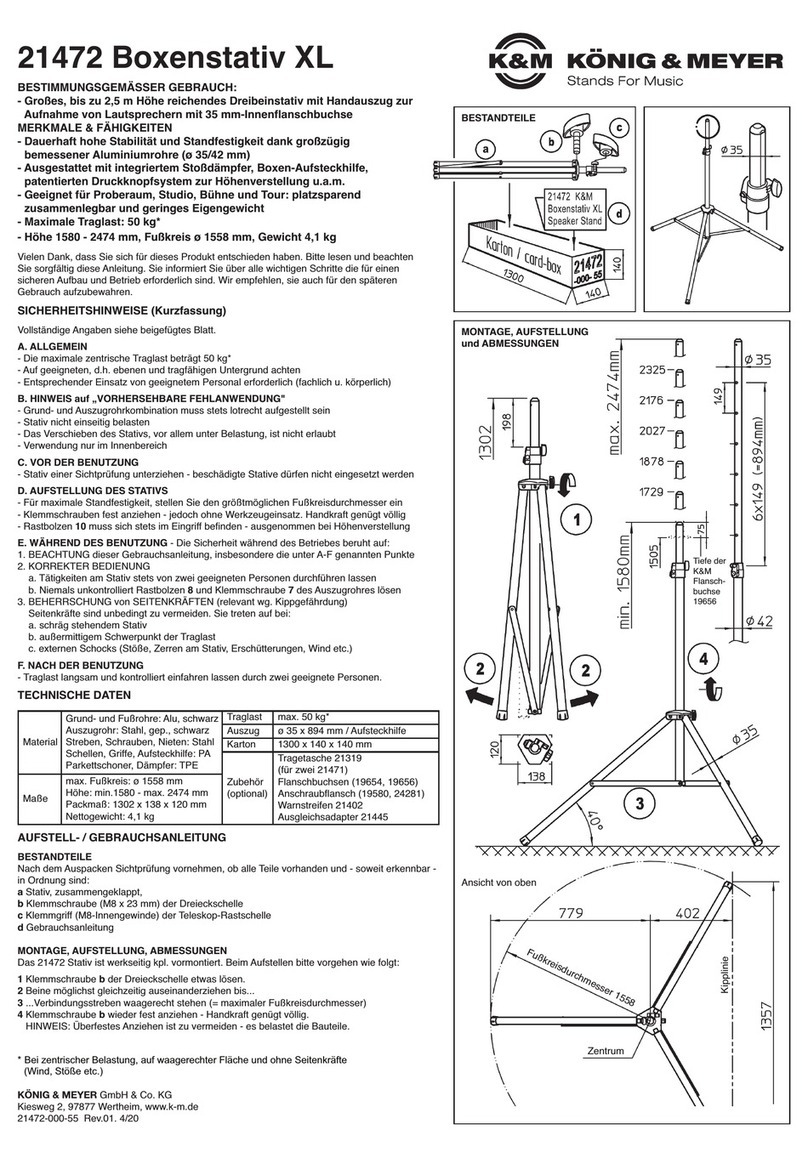
Konig & Meyer
Konig & Meyer Speaker stand XL 21472 User manual
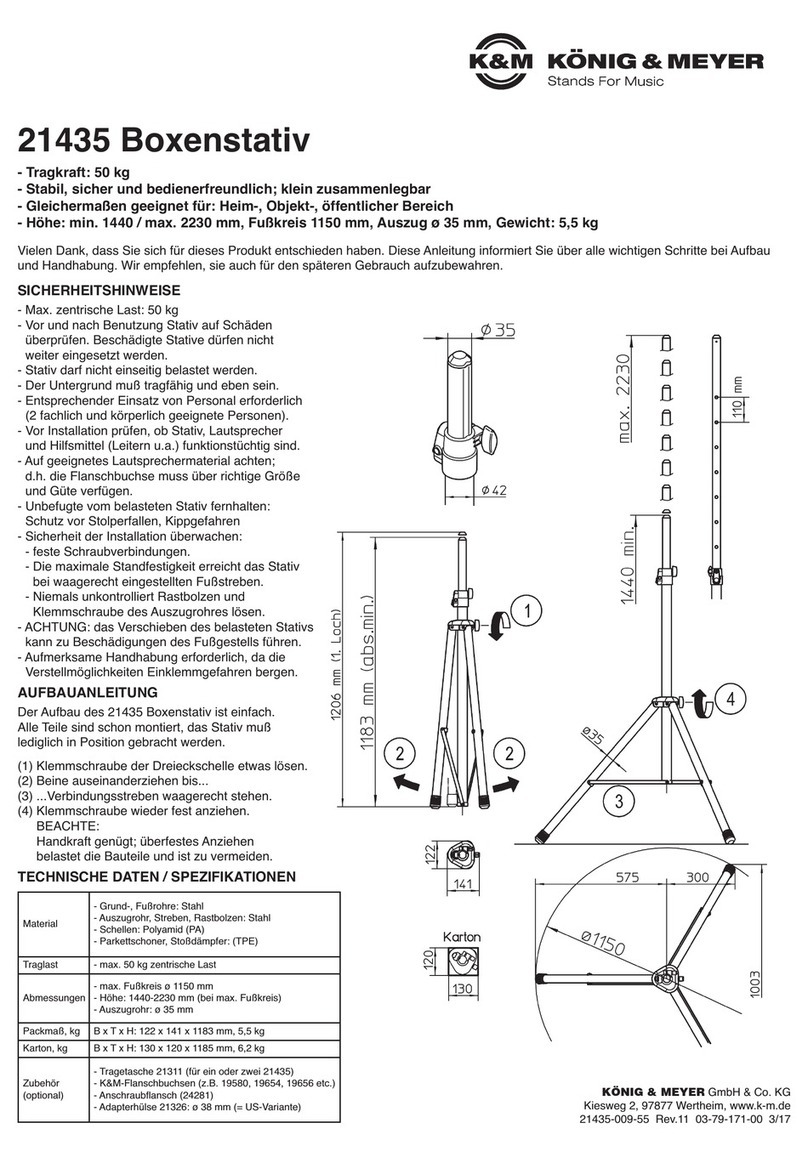
Konig & Meyer
Konig & Meyer 21435 User manual
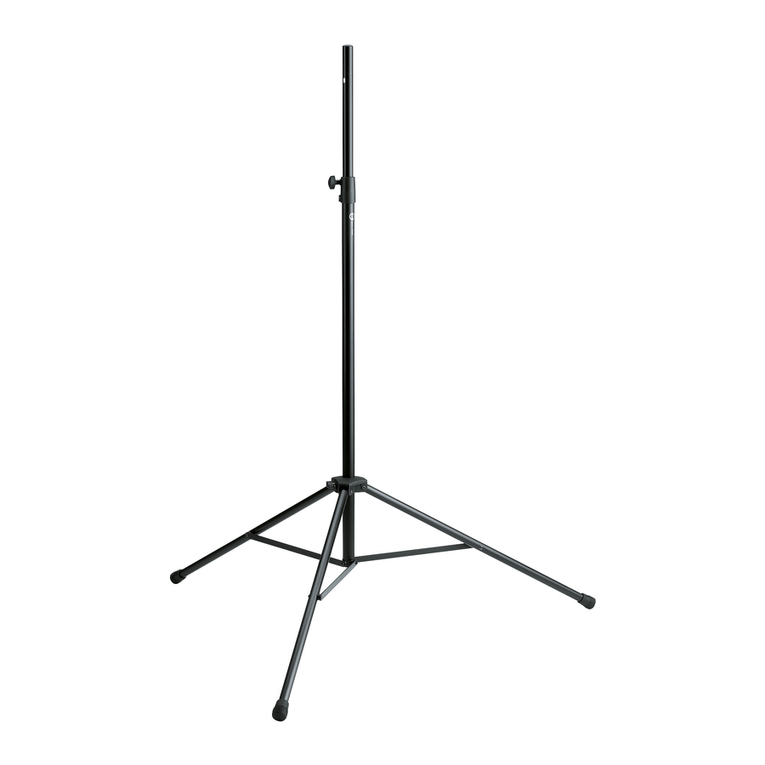
Konig & Meyer
Konig & Meyer 21420 User manual
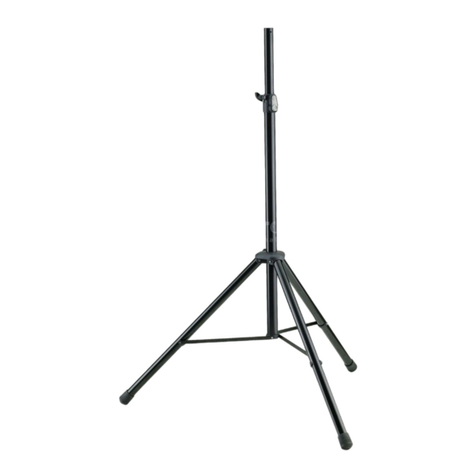
Konig & Meyer
Konig & Meyer 21435 User manual
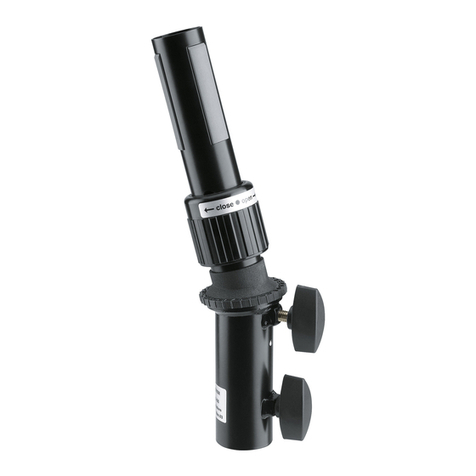
Konig & Meyer
Konig & Meyer Ring Lock User manual
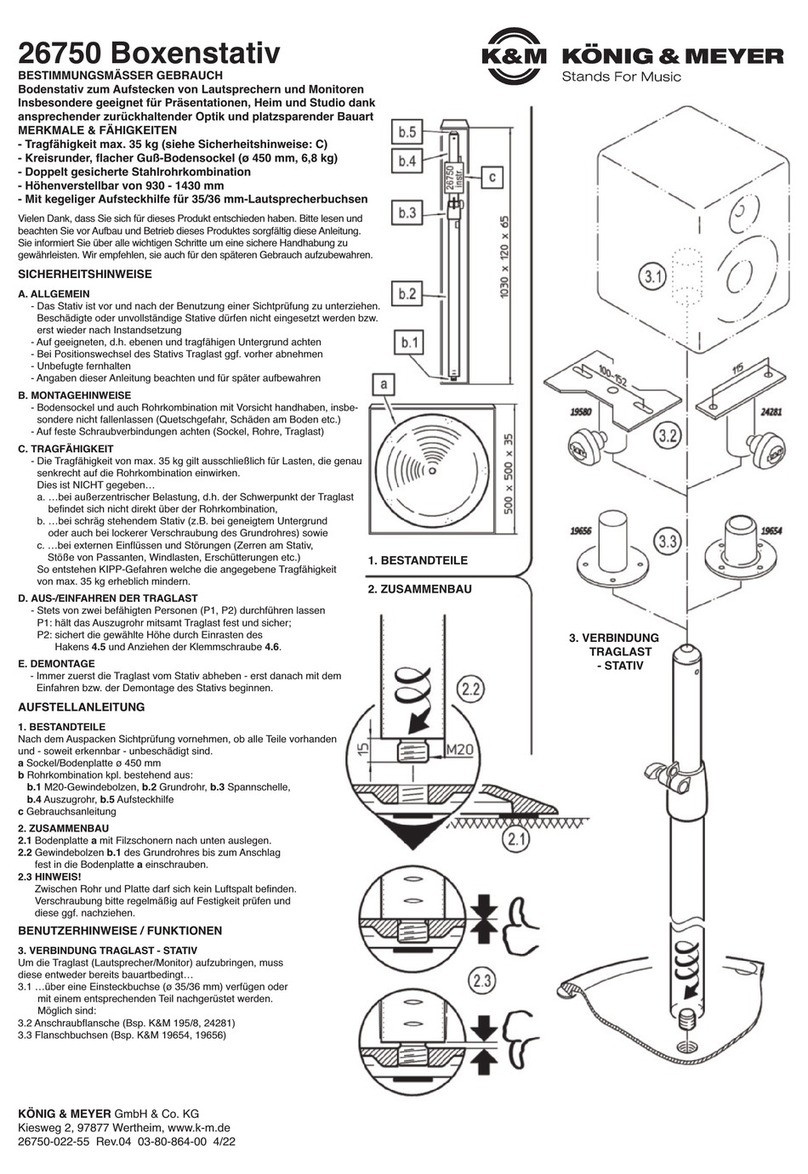
Konig & Meyer
Konig & Meyer 26750 User manual
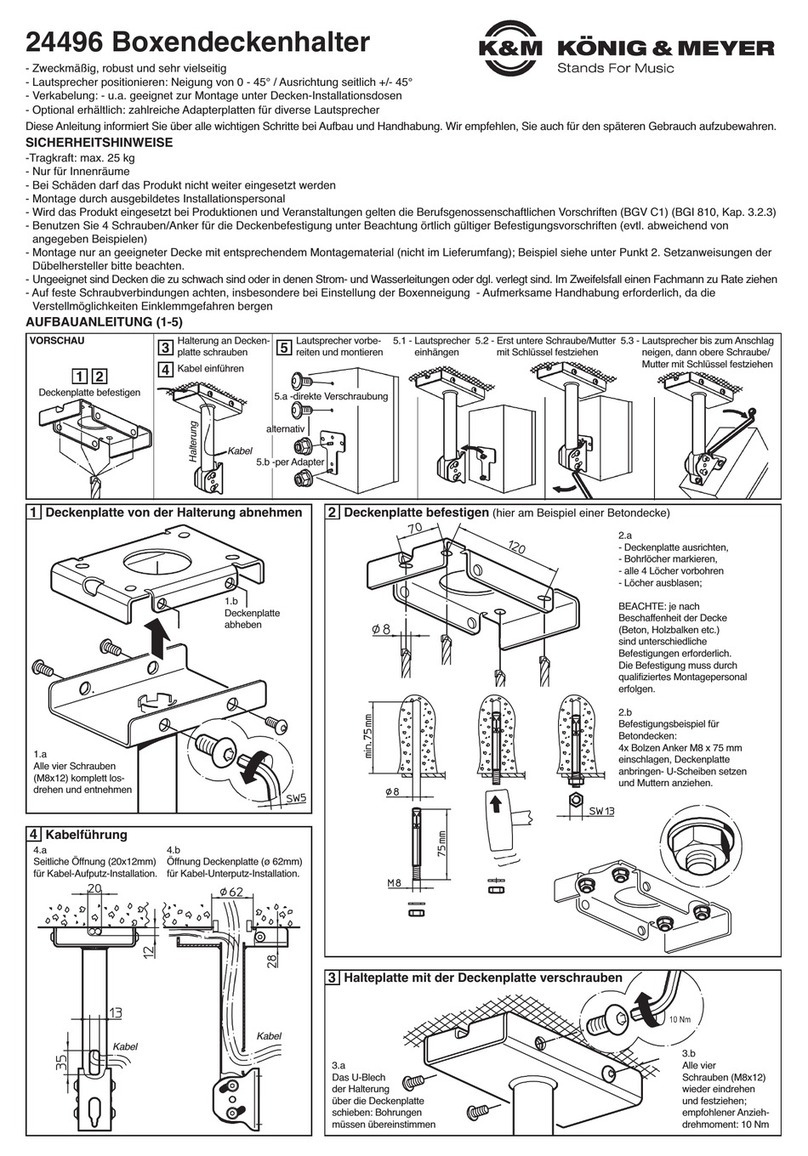
Konig & Meyer
Konig & Meyer 24496 User manual
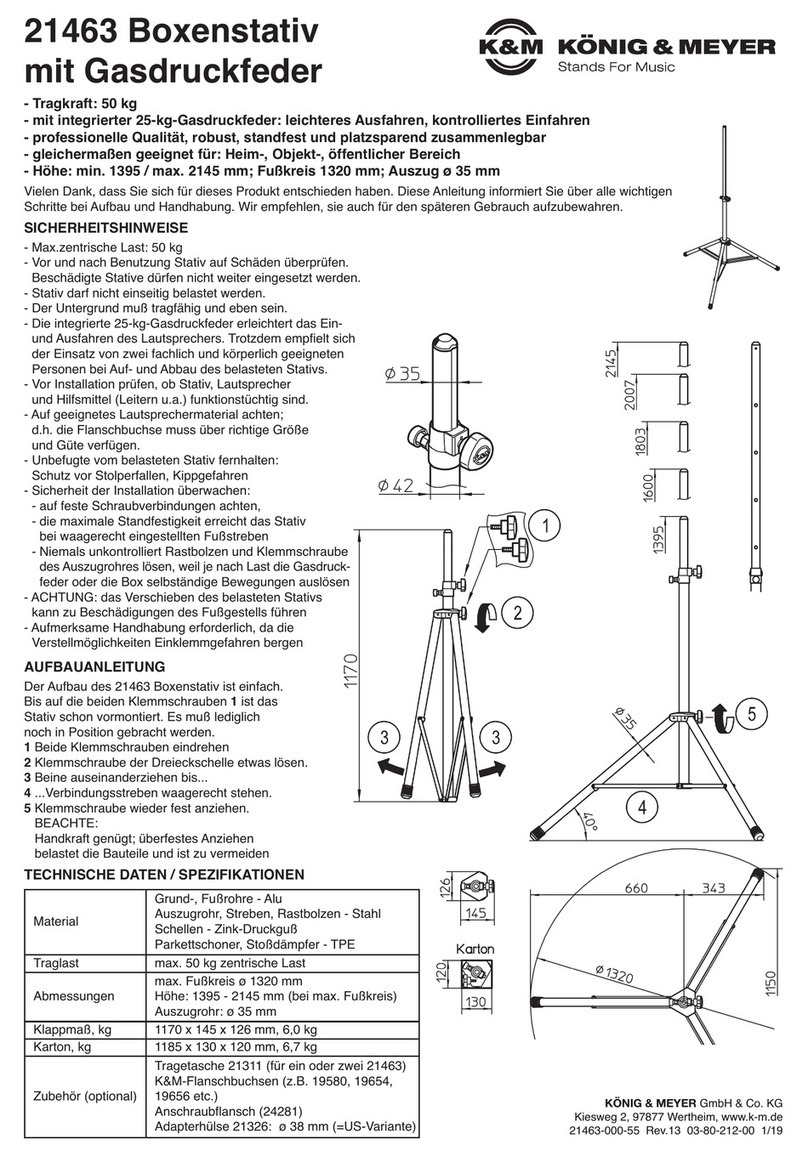
Konig & Meyer
Konig & Meyer 21463 User manual
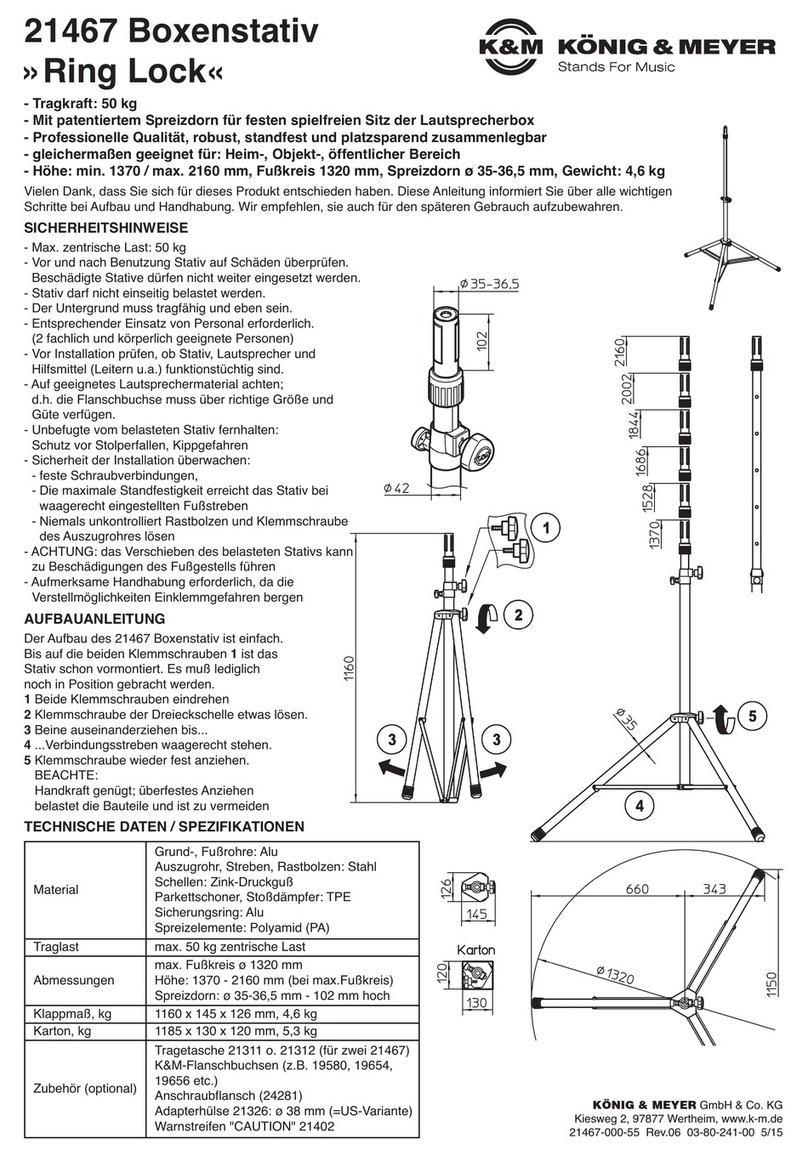
Konig & Meyer
Konig & Meyer Ring Lock 21467 User manual
